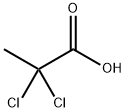Dalapon is a commonly used herbicide for the control of
annual and perennial grasses in croplands. The US Environmental
Protection Agency (EPA) has listed dalapon as
a general use pesticide and categorized dalapon as a Class II
toxic agent (moderately toxic). As such, any product that
contains dalapon would be labeled with ‘warning.’ The
moderate toxicity associated with dalapon is confined
primarily to workers around dalapon and those individuals
who are applying dalapon. Contact with the herbicide can
be caustic to human skin, damaging to the conjunctiva of
the human eye, and irritating/damaging to the upper
respiratory system of humans. When used to control grasses
in cropland as well as noncropland, dalapon is distributed
via either aerial or ground equipment for foliage application.
Some of the common croplands that have benefitted
from dalapon application include corn, potatoes, legume
crops, citrus, fruit, and nut trees. It is used extensively in the
western United States to control a variety of grasses such as
Bermuda, Johnson, Crab, and Quack grasses. Dalapon is
translocated to the roots where it acts as a growth regulator.
Although highly soluble with the ability to readily move
through the environment, dalapon is relative safe and
instances of dalapon intoxication are rare. The primary
sources of toxicity are contact with the sodium or magnesium
salt of dalapon, which is an irritant to the eyes, skin,
and respiratory system. Cases of elevated levels of dalapon
in drinking water or groundwater have also been rare, and
little toxicity has been reported following dalapon exposure
in water. Individuals who were exposed to high levels for
extended periods of time can experience kidney dysfunction.
Collectively, dalapon is a relatively safe herbicide for
the control of many annual and perennial grasses.

